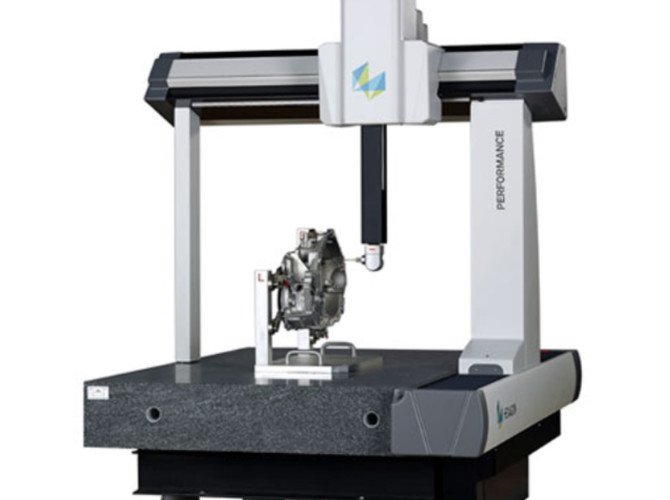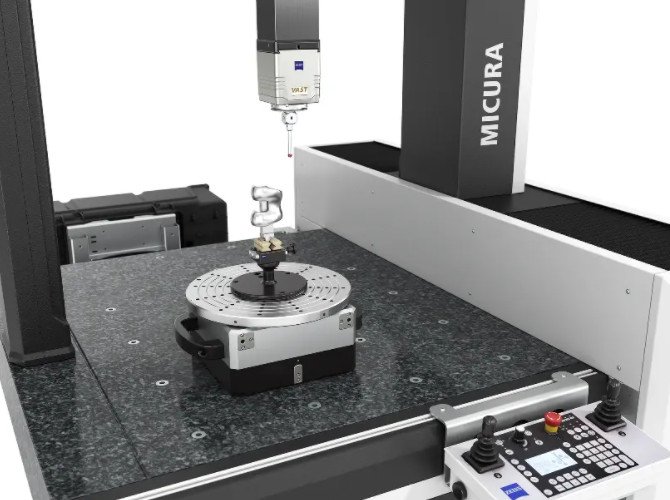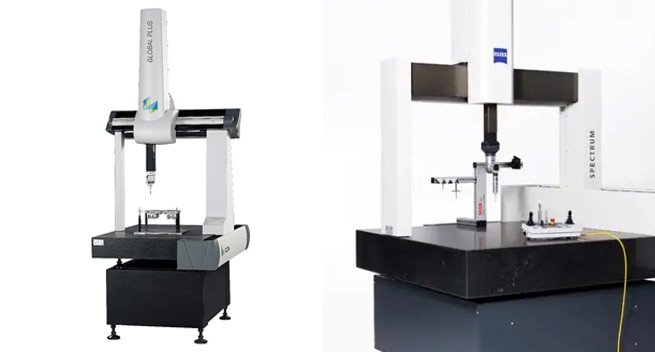Coordinate Measuring Machines (CMMs) are essential for precision metrology in industries like aerospace, automotive, and electronics. Hexagon Manufacturing Intelligence and ZEISS are leading brands in this field, each offering distinct advantages in accuracy, product diversity, software functionality, pricing, and market applications. This article provides a systematic, technical comparison of Hexagon and ZEISS CMMs, incorporating detailed specifications and practical considerations to guide professionals in selecting the optimal CMM for their needs.
Accuracy and Performance
Accuracy is a critical factor in CMM selection, as it directly impacts measurement reliability. Both Hexagon and ZEISS offer high-precision solutions, but their approaches differ slightly.
ZEISS Accuracy
ZEISS, a German brand with a legacy of precision engineering, is renowned for its exceptional accuracy. The ACCURA series, for instance, supports all ZEISS RDS-based scanning probes, achieving a length measurement error (E0) as low as 1.2 + L/350 μm. The PRISMO fortis, designed for shop-floor integration, maintains high accuracy and repeatability, with an E0 of 0.9 + L/350 μm, even during high-speed scanning. ZEISS CMMs feature high dynamic rigidity, ceramic components, and air bearings to minimize measurement deviations. Additionally, ZEISS incorporates temperature isolation, vibration damping, and shielding enclosures to reduce environmental impacts, ensuring consistent performance in varied conditions.
Hexagon Accuracy
Hexagon’s CMMs also deliver high accuracy, particularly in premium models like the Leitz PMM Gold, which achieves an ultra-high precision of 0.28 + L/400 μm. The GLOBAL S series, a versatile bridge CMM, offers an E0 of 1.2 + L/333 μm, suitable for general-purpose applications. However, while Hexagon’s high-end models rival ZEISS in precision, its mid- and low-end models may exhibit slightly less consistency and stability, particularly in demanding environments. Hexagon compensates with robust temperature compensation and durable designs, making its CMMs reliable for production floor use.
Comparison: ZEISS excels in consistent high-precision performance, especially for stringent tolerance requirements, while Hexagon offers competitive accuracy with broader environmental adaptability in its mid-range models.


Product Range and Configurations
The diversity of CMM configurations determines their suitability for various measurement tasks. Both brands offer a wide range of models tailored to different industries and part sizes.
ZEISS Product Range
ZEISS provides a focused but versatile portfolio of CMMs, including:
- CONTURA: Designed for flexible, performance-level measurements, with a range of X: 700–1200 mm, Y: 700–1800 mm, Z: 600–1000 mm, and an E0 of 1.8 + L/350 μm. Ideal for medium-sized parts.
- MICURA: Tailored for small parts with tight tolerances, offering an E0 of 0.7 + L/400 μm and a compact range of X: 500 mm, Y: 500 mm, Z: 500 mm.
- XENOS: A high-rigidity, high-speed CMM for precision applications, with an E0 of 0.3 + L/400 μm and a range of X: 900 mm, Y: 1500 mm, Z: 700 mm.
- PRISMO: Known for high-speed scanning, with a range of X: 700–1600 mm, Y: 900–4200 mm, Z: 500–1400 mm, and an E0 of 0.9 + L/350 μm.
ZEISS’s CMMs cater to industries requiring high precision, such as aerospace and medical device manufacturing, with specialized models for small, complex, or large components.
Hexagon Product Range
Hexagon offers a broader portfolio, covering multiple CMM types:
- Bridge CMMs (GLOBAL S): Measurement range of X: 500–1200 mm, Y: 500–3000 mm, Z: 500–1000 mm, with an E0 of 1.2 + L/333 μm, suitable for general-purpose applications.
- Ultra-High Precision (Leitz PMM Gold): Offers an E0 of 0.28 + L/400 μm for lab-grade measurements.
- Horizontal Arm (DEA Bravo): Designed for sheet metal and large parts, with a range of X: up to 4000 mm, Y: up to 1600 mm, Z: up to 2000 mm.
- Gantry (Galaxy D): For large components, with a range of X: 1–20 m, Y: 800–1400 mm, Z: 800–3000 mm.
- Portable (ROMER Absolute Arm): Offers flexibility for on-site measurements, with accuracies up to 0.023 mm.
Hexagon’s extensive range supports diverse applications, from large aerospace components to portable measurements in automotive and electronics industries.
Comparison: ZEISS offers a streamlined portfolio optimized for precision, while Hexagon provides greater variety, including portable and large-scale solutions, catering to a wider range of industrial needs.
Software Functionality
Software plays a pivotal role in CMM usability, programming efficiency, and data analysis. Both brands offer advanced software, but their strengths differ.
ZEISS CALYPSO Software
ZEISS’s CALYPSO software is highly compatible with its CMMs, offering a user-friendly interface and robust features. Key functionalities include:
- PiWeb Integration: Provides basic reporting and statistical analysis for detailed measurement reports.
- Navigator Technology: Enables rapid programming and high-speed scanning, reducing setup time.
- FlyScan: Allows fast scanning of interrupted contours, cutting programming and measurement time by up to 25%.
- Probe Compatibility: Seamlessly integrates with ZEISS VAST, RDS, and optical probes for versatile measurements.
CALYPSO’s intuitive design and advanced reporting make it ideal for users prioritizing ease of use and precision data analysis.
Hexagon PC-DMIS Software
Hexagon’s PC-DMIS is a versatile metrology software compatible with multiple CMM brands. Its features include:
- CAD Integration: Supports complex 3D model creation, enhanced by acquisitions like Geomagic for reverse engineering.
- Automation: Offers collision detection, path optimization, and automated part programs for high-throughput environments.
- Probe Support: Compatible with tactile, optical, and multisensor probes, including automated probe changers.
While PC-DMIS is powerful, its programming interface is less intuitive than CALYPSO, potentially requiring more training. Recent updates have improved its 3D modeling and automation capabilities.
Comparison: CALYPSO excels in user-friendliness and rapid programming, while PC-DMIS offers greater versatility and cross-platform compatibility, though with a steeper learning curve.
Pricing and Cost Considerations
Pricing is a significant factor in CMM selection, particularly for budget-conscious organizations.
ZEISS Pricing
ZEISS CMMs are positioned in the premium market, reflecting their advanced technology and precision. Models like XENOS and PRISMO command higher prices due to their superior accuracy and specialized features. Additionally, ZEISS’s after-sales services, including maintenance and training through ZEISS Academy Metrology, are relatively expensive, which may impact total cost of ownership.
Hexagon Pricing
Hexagon offers a broader price range, catering to various budgets. Its mid- and low-end models, such as the GLOBAL Lite, are more affordable, making them accessible to small and medium-sized enterprises. High-end models like Leitz PMM Gold are priced comparably to ZEISS’s premium offerings but offer cost-effective alternatives for less demanding applications. Hexagon’s global service network also provides competitive maintenance options.
Comparison: ZEISS targets the high-end market with premium pricing, while Hexagon offers cost-effective solutions across a wider range, appealing to diverse budgets.
Market Share and User Base
Both brands have strong market presence but serve slightly different user bases.
ZEISS Market Presence
ZEISS holds a significant share of the high-end CMM market, particularly in industries requiring extreme precision, such as aerospace, precision mechanics, and optics. Its reputation for quality makes it a preferred choice for global enterprises like Airbus and Siemens, where tight tolerances are critical.
Hexagon Market Presence
Hexagon is one of the largest metrology equipment manufacturers globally, with a broad user base spanning automotive, electronics, molds, and heavy machinery. Major clients like Foxconn rely on Hexagon’s CMMs for their versatility and scalability in high-volume production environments.
Comparison: ZEISS dominates in precision-driven industries, while Hexagon’s extensive portfolio and affordability make it a go-to choice for diverse, high-volume applications.
Key Specifications Comparison
| Feature | Hexagon GLOBAL S | ZEISS PRISMO |
|---|---|---|
| Measurement Range (X/Y/Z) | 500–1200/500–3000/500–1000 mm | 700–1600/900–4200/500–1400 mm |
| Length Measurement Error (E0) | 1.2 + L/333 μm | 0.9 + L/350 μm |
| Max Scanning Speed | Up to 600 mm/s | Up to 800 mm/s |
| Temperature Range | Up to 40°C | 15–40°C (with HTG option) |
Limitations and Considerations
While both brands offer robust solutions, certain limitations should be noted:
- ZEISS: High initial and maintenance costs may be a barrier for smaller businesses. The reliance on proprietary software and probes can limit flexibility for users with existing non-ZEISS systems.
- Hexagon: The steeper learning curve of PC-DMIS may require additional training time. Mid- and low-end models may not match ZEISS’s precision consistency in demanding applications.
These considerations are critical for users balancing cost, precision, and ease of use.
Conclusion
Hexagon and ZEISS CMMs cater to diverse metrology needs with distinct strengths. ZEISS excels in high-precision applications, offering superior accuracy, user-friendly software, and specialized models for industries like aerospace and optics. Hexagon provides a broader, more cost-effective range, with versatile configurations and software suited for high-throughput industries like automotive and electronics. By evaluating accuracy requirements, budget constraints, and application needs, users can choose the CMM that best aligns with their operational goals.

